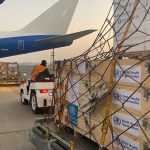Changi Airport Southeast Asia’s powerhouse cargo hub
In 2022, Singapore Changi Airport ranked as the 10th busiest air cargo hub by international airfreight, firmly establishing itself as Southeast Asia’s prime gateway for international cargo traffic. A remarkable 1.85 million tons of airfreight passed through its terminals in 2022, with an impressive 1.3 million tons handled within the first nine months of 2023. Notably, Singapore achieved the pinnacle of logistics excellence by topping the World Bank’s 2023 Logistics Performance Index (LPI) in trade logistics performance.
As a leading global air cargo hub, Singapore Changi Airport’s success hinges on building trust, enhancing service quality, and delivering unwavering reliability. This pursuit of excellence is underpinned by a strategic focus on fostering network and connectivity, improving operational efficiency, and bolstering handling capabilities through robust partnerships and community stewardship.
At the heart of its prowess lies a vibrant ecosystem of airlines, express integrators, logistics service providers, freight forwarders, truckers, and ground handlers, all seamlessly connected to approximately 140 global cities.
With over 100 airlines, including 30 freighter operators, and 530 weekly flights, the airport boasts one of the most expansive networks in the Asia Pacific, firmly positioned at the forefront of Southeast Asia’s expanding manufacturing, trade, and logistics landscape.
Pharma Excellence and European Expansion:
Moreover, the airport excels in catering to the unique needs of special cargo, such as pharmaceuticals, perishables, high-tech, and e-commerce. In 2017, Changi Airport Group (CAG) launched the Pharma@Changi Initiative, uniting IATA CEIV Pharma-certified companies in Changi.
This initiative is dedicated to elevating air pharma transportation standards, ensuring that all staff involved maintain the product’s integrity. Pharma@Changi underscores its commitment to becoming the trusted regional pharma gateway.
Additionally, Europe became the airport’s second-largest air trade region in 2022, with a key trade lane to Belgium for high-value cargo like biopharmaceuticals. In March 2023, CAG signed an MOU with Brussels Airport Company to enhance pharma air logistics and share best practices. The launch of non-stop passenger services to Brussels in April 2024 will expand cargo capacity between Singapore and Belgium.
E-commerce Advancements and Community Collaboration:
E-commerce is a vital segment for the airport. The Southeast Asian e-commerce market is set to triple, growing at a CAGR of 22%. The airport welcome an MOU between SATS and SingPost (Singapore’s national postal agency) to establish an advanced eCommerce transshipment hub in Singapore, streamlining cargo logistics for quicker deliveries and cost reduction.
The airport is forging a more interconnected air cargo ecosystem, fostering community collaboration. The Changi Air Cargo Community System (ACCS), with its Truck Dock Slot Booking (TDSB) application, streamlines cargo processes and enhances transparency. The completed pilot phase paves the way for a community-wide rollout in early 2024, aligning with its sustainability goals.
To gain a more profound insight into CAG’s air cargo strategies and its vision for the future, Air Cargo Update had the opportunity to sit down with Lim Ching Kiat, the Executive Vice President of Air Hub & Cargo Development at Changi Airport Group (CAG).
In this exclusive interview, he sheds light on the airport’s pioneering approaches and forward-looking initiatives in the field of air cargo. Let’s hear directly from him about CAG’s commitment to excellence and its plans to shape the future of air cargo.
How is CAG integrating technology, including AI and robotics, to enhance air cargo efficiency?
CAG is collaborating with its partners to trial autonomous solutions, such as autonomous tractors, to reduce manpower in airport ramp operations, including baggage and cargo transport. Promising trials are already underway, and Changi anticipates achieving fully driverless baggage delivery operations by 2024. Additionally, the airport is implementing asset-tracking solutions for motorized ground support equipment to achieve optimized deployment, increase productivity, and enhance overall ramp handling.
The airport’s cargo terminal operators are also investing in warehouse automation and digitalization projects to address manpower challenges and enhance efficiency and capacity. In partnership with logistics technology solutions provider Speedcargo, dnata has implemented Cargo Eye and Assemble solutions for Etihad Cargo at Changi Airport. Cargo Eye employs advanced vision-based 3D technology to capture precise dimensions, volume data, images, and labels of the cargo, creating a comprehensive digital record. Assemble then generates a digital plan, optimizing the pallet-building process and providing valuable guidance to cargo handling teams. This innovative technology is being considered for integration with other airline partners, contributing to the continuous improvement of business operations.
What sustainability initiatives has the airport undertaken to reduce its environmental impact in air cargo operations?
Sustainability is a significant focus for the airport. In its endeavor to build a more sustainable air cargo hub, the airport adopts a comprehensive and community-oriented approach. Key areas of emphasis in CAG’s environmental sustainability strategy encompass mitigating carbon emissions, enhancing waste management, transitioning airside vehicles to cleaner energy sources, and intensifying collaborations with industry partners to create a more sustainable Changi.
Leveraging technology and digitalization, the airport not only streamlines processes and enhances supply chain efficiency but also reduces the environmental impact of air cargo operations. For instance, the Truck Dock Slot Booking (TDSB) system within the Changi Air Cargo Community System (ACCS) platform optimizes trucking operations, minimizing idle time, and significantly decreasing carbon emissions from cargo transportation.
The airport is also committed to improving waste management practices and advancing toward a circular economy. At the Changi Airfreight Centre (CAC), CAG actively implements strategies to minimize waste generation.
In the domain of sustainable energy, CAG has established more than 100 Electric Vehicle (EV) charging stations at its airside facilities, backing an entirely electric baggage tractor fleet. Beginning in 2025, all newly acquired airside light vehicles, tractors, and forklifts will be mandated to be electric, with an aspiration for all airside vehicles to be powered by more environmentally friendly sources by 2040.
Over the coming years, the charging network will expand to over 300 points, aligned with its airport partners’ needs. The EV charging infrastructure at the CAC will also undergo upgrades. For vehicles and equipment that lack viable electric alternatives, Changi is conducting trials to power them with renewable diesel.
With the primary objective of reducing carbon emissions in the aviation sector, CAG collaborates closely with industry and regulatory partners, facilitating trials and engaging stakeholders to promote the adoption of Sustainable Aviation Fuel (SAF). The expansion of Neste’s refinery in Singapore will enable the annual production of up to one million tons of SAF, allowing the airport’s airline partners to achieve their sustainability goals.
As a founding and strategic member of Pharma.Aero, CAG plays an active role in developing and driving projects to enhance air pharma transportation. A notable project is the Green Air Pharma Logistics, where Changi and project partners aim to establish a green air pharma lane with qualitative and quantitative measurements. These collaborative initiatives underscore the airport’s unwavering commitment to global sustainability efforts and the pursuit of greener air cargo logistics.
What are the airport’s plans for the new air cargo terminal at Terminal 5, and how will it enhance its capacity and capabilities?
The airport’s long-term vision encompasses the Changi East Development, featuring the construction of the new Terminal 5 and the establishment of the new Changi East Industrial Zone (CEIZ). The CEIZ is set to become a preferred hub for airfreight, air express, e-commerce transshipments, and MRO activities, with a slated completion date in the mid-2030s. This expansion will also bring about a substantial increase in freighter bays, enabling the airport to better serve freighter operations in the future.
In conjunction with the revitalized CAC, which forms an integrated cargo village, the airport’s cargo handling capabilities are set to increase from the current 3 million tons per annum to 5.4 million tons annually at the end state. The upcoming CEIZ will provide an opportunity for the airport and its cargo partners to grow, strengthen their operations, and tap into emerging opportunities.
Lastly, what are the airport’s future air cargo opportunities and challenges, and how is it preparing for them?
The challenges encountered by most air cargo hubs include the constant rise in costs, labor shortages, environmental sustainability concerns, and the ever-increasing expectations of shippers.
Changi Airport recognizes the pivotal role of technology and automation as catalysts for sustainable, long-term air cargo growth. Initiatives like the TDSB application integrated within the Changi ACCS platform, autonomous tractors, and asset tracking solutions for ground support equipment exemplify the airport’s commitment to utilizing technology and automation to unlock greater productivity and capacity for the hub.














